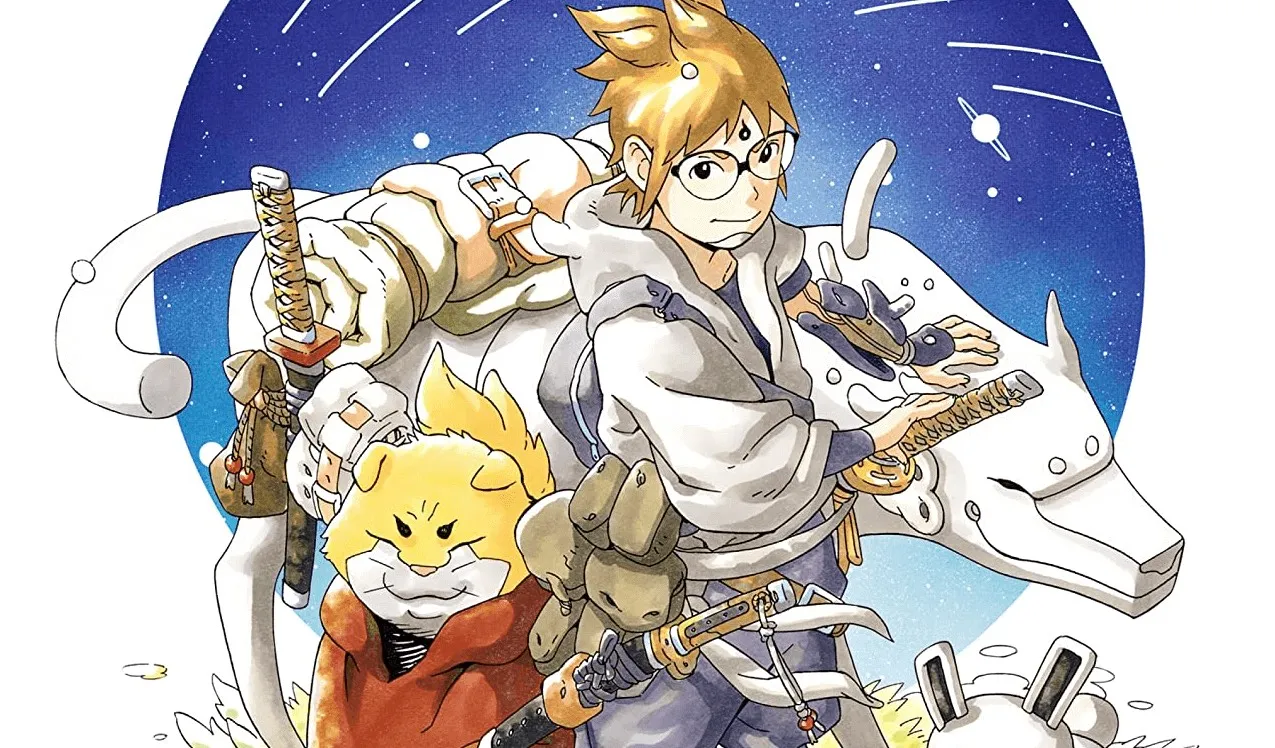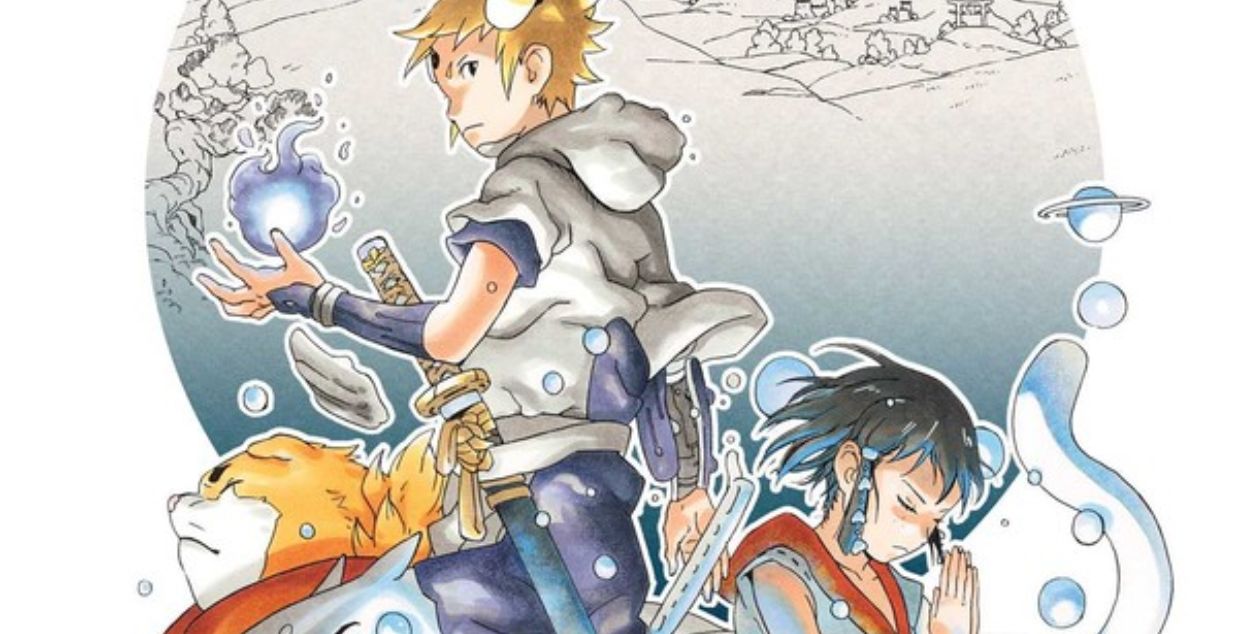This Samurai 8: The Tale of Hachimaru review explores Masashi Kishimoto’s bold sci-fi samurai adventure. From a fragile boy’s dream of becoming a warrior to a vibrant universe filled with cyborgs, shape-shifting animals, and intergalactic battles, the manga blends tradition with futuristic flair. While its world-building is dazzling, the storytelling has both strengths and weaknesses worth discussing. On ComicK, this title stands out as a unique blend of classic samurai tropes and cosmic-scale imagination.
When I first picked up Samurai 8 on ComicK, I wasn’t sure what to expect. Coming from Masashi Kishimoto, the legendary creator of Naruto, I had high hopes but also some doubts could he really break free from his past and create something fresh? The answer, after diving into Hachimaru’s story, is a resounding yes. This manga isn’t just another shōnen title; it’s a bold fusion of science fiction, samurai tradition, and heartfelt character growth.
Reading it felt like stepping into a world where ancient codes of honor meet futuristic technology, where cyborg bodies and floating animals coexist with swords and warriors. That mixture instantly hooked me, and the deeper I went, the more I realized this wasn’t just a gimmick it’s a whole philosophy of storytelling. If you’re someone who loves both high-octane action and thoughtful world-building, this series is a must-try.
Let’s dive into what makes Samurai 8 such an intriguing read, both for long-time fans of Kishimoto and for newcomers hungry for a unique manga experience.
A World Where Samurai and Sci-Fi Collide
The first thing that strikes you in Samurai 8 is the setting. Unlike most futuristic manga that lean on cold metallic tones and sterile designs, Kishimoto crafts a universe that feels strangely organic. The cyborg samurai and their animal companions aren’t just machines they breathe, shift, and flow with a sense of life. It gives the story a vibrant texture that immediately sets it apart.

What impressed me most is how the art balances complexity and fluidity. From the rounded contours of robotic armor to the wild forms of animal guardians, every page bursts with creativity. It’s a world that feels alive, not mechanical, and that’s a rare achievement in sci-fi storytelling.
Yet, as much as I admired the artwork, I also noticed a small drawback character expressions. While the settings overflow with detail, the faces sometimes fall flat, lacking the emotional punch you’d expect. Still, the universe itself is so imaginative that it often overshadows this flaw.
Hachimaru: From Fragile Boy to Reluctant Hero
At the heart of Samurai 8 lies Hachimaru, a boy who starts life trapped in weakness. He’s sickly, unable to leave his home, and seemingly destined for a life of limitation. And yet, like so many great heroes, his heart longs for freedom, adventure, and honor. His journey resonates because it’s not just about becoming strong it’s about proving that even the weakest beginnings can lead to greatness.
What I loved most about Hachimaru is that his growth feels both fantastical and relatable. His transformation into a samurai isn’t just a power-up moment; it’s a leap into the unknown, filled with mistakes, risks, and a reckless sense of hope. You root for him not because he’s perfect, but because he dares to chase what seems impossible.
This kind of storytelling is where Kishimoto shines. Just like Naruto once embodied resilience, Hachimaru captures the spirit of longing a reminder that courage often starts where comfort ends.
The Strengths and Weaknesses of the Storytelling
As breathtaking as the setting and characters are, the narrative of Samurai 8 isn’t without flaws. The pacing can feel uneven, throwing readers into unfamiliar terms and concepts without much context. One moment you’re immersed in cosmic lore, the next you’re wondering if you missed a crucial explanation.
That said, once you settle into the rhythm, it starts to click. Kishimoto uses repetition cleverly introducing a term vaguely, then looping back later to clarify it. For some readers, this feels frustrating; for others, it mirrors the process of discovery, as though you’re learning the rules of the universe alongside the characters.
The real test of patience comes in the plot escalation. Events sometimes leap forward so quickly that the emotional buildup doesn’t always land. But even in those moments, the sheer energy of the battles and the underlying themes of destiny keep you turning pages.
Familiar Tropes with a Fresh Twist
If you’ve read your fair share of samurai or shōnen stories, you’ll notice some familiar beats in Samurai 8. The mysterious mentor, the rival with a hidden past, the young hero diving headfirst into battles it’s all there. But instead of feeling recycled, these tropes are reframed through the lens of sci-fi and interstellar mythology.
For instance, the concept of honor isn’t tied just to clan wars or feudal politics it’s extended to cosmic battles across galaxies. The animal guardians aren’t mere sidekicks; they’re an extension of the samurai’s soul, blending technology with spirit in a way that feels both ancient and futuristic.
This balance of old and new is exactly why the series feels so refreshing. Kishimoto doesn’t try to erase his shōnen roots; he reimagines them, layering them over a sci-fi foundation that opens new storytelling possibilities.

Comparing Samurai 8 to Naruto
I’d be lying if I said I didn’t constantly compare Samurai 8 to Naruto. After all, both series spring from the same creative mind. And yes, you’ll find echoes young heroes striving for recognition, worlds built on codes of honor, battles that push characters to their limits.
But the differences are just as striking. Where Naruto was grounded in ninja villages and interpersonal conflicts, Samurai 8 leaps into outer space, tackling themes of destiny, cosmic order, and humanity’s place in a technological universe. It feels less like a coming-of-age drama and more like a mythic quest told across galaxies.
That shift in scope gives Samurai 8 its unique identity. If you’re worried this is just “Naruto with samurai,” let me assure you it’s not. It’s Kishimoto proving he can stretch his vision into something daringly new.
Why You Should Read Samurai 8 on ComicK
When I finished the first volume of Samurai 8, I couldn’t help but feel both exhilarated and curious for what comes next. It’s not flawless the pacing hiccups and occasional flat expressions may frustrate some but the sheer creativity of the world, the sincerity of Hachimaru’s journey, and the unique fusion of genres make it stand out.
If you’re a fan of action-packed adventure but want something fresher than the usual shōnen formula, this manga is worth your time. It has the energy of a space opera, the honor of a samurai epic, and the personal growth of a classic hero’s tale all in one package.
Available on ComicK, Samurai 8: The Tale of Hachimaru is a series that invites you to step into a world both familiar and new. Whether you’re a Kishimoto loyalist or just hunting for your next great read, this story promises a ride unlike any other.
Read more:
- Unveiling Monster: From Clean-Up Crew to Kaiju Hero
- Review: Came the Mirror – Rumiko Takahashi Short Story Collection
